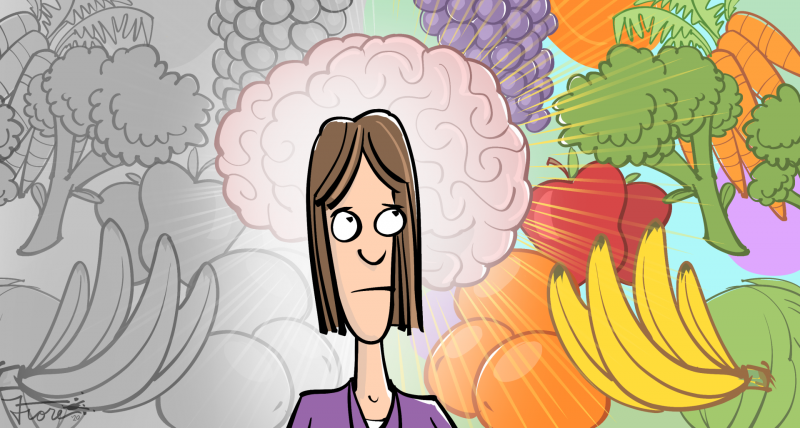At the beginning of the coronavirus crisis, Margo Henderson ordered a lot of takeout pizza and quesadillas. But she worried that the greasy comfort foods she indulged in at the pandemic’s outset had nudged her down a slippery slope.
When Picky Eating Becomes a Dangerous Disorder

For most of her 29 years, Henderson has grappled with an eating disorder that caused a deep aversion, even disgust, for most foods.
“I grew up pretty much on an all-beige diet,” she said, perched on the edge of her weathered leather couch in a sparsely furnished San Francisco apartment. “Absolutely nothing green. No fruits or vegetables. I pretty much had the palate of a 4-year-old until I was 25.”
When she was a child, her mother tried bribing her with treats. Sometimes her mom refused to let her leave the table if she didn’t eat something other than bread and pasta. When those tactics failed, her mother dragged her to pediatricians, dieticians and even a hypnotist. The specialists shrugged off her intolerant palate as age-related.
But fussy eating was more than a phase. Even into adulthood, Henderson preferred the kids menu. She cringed at the sight and smell of certain foods, especially cold and crunchy items like salads or pickles. Her stomach lurched when she neared the produce section of a grocery story. While a lot of people will opt for the fries instead of the salad, just the sight of lettuce next to a burger nauseated Henderson. Her worst nightmare was a boxed lunch.
“Like, God forbid someone gave me a turkey sandwich with soggy lettuce and tomato that’s been all touching,” said Henderson. “Even if you were sitting next to me eating a carrot stick or a celery stick, I’d gag.”
As the years passed, her limited diet led to greater isolation. She always had a menu of excuses at the ready in case of invitations: Let’s just do drinks. I’m not hungry. I don’t want dinner.
“Food was such an anxious thing in my life,” she said. “I definitely tried to steer away from it. I had such a strong physical reaction to being around food, let alone eating it.”
Though Henderson was never diagnosed with any medical complications stemming from her restricted eating habits, she frequently felt sluggish.
“It definitely affected my energy level,” she said. “My skin was really gray-looking.”
She knew something was wrong, but what? She didn’t have a name for it, let alone a solution.
A New Diagnosis
Then one night while surfing the web, Henderson stumbled across a link on avoidant/restrictive food intake disorder, or ARFID. She was stunned. For the first time in her life, she read about other people who were repulsed by certain flavors, aromas and textures.
Doctors are still studying what causes the illness. Unlike other eating disorders, it’s not related to body image. Early research suggests that people who have ARFID are not just extreme versions of a choosy young eater, but potentially “supertasters.”
“Meaning that their palates are much more sensitive and they taste things in a really intense way,” said Erin Accurso, clinical director of the UCSF Eating Disorders Program.
A traumatic event like a choking incident or a bad case of food poisoning can trigger the disorder, Accurso says. Over time, someone’s initially small roster of disliked foods tends to lengthen, until their eating selection has become uncommonly narrow.
Common behaviors include food avoidance, loss of appetite, abdominal pain and fear of vomiting. Eventually, ARFID can lead to nutritional deficiencies, weight loss and depression. One British teenager who ate only chips, sausages, processed ham and white bread lost his sight permanently after malnutrition led to optic nerve damage.
Henderson and her doctors speculate her sensitivities stemmed from a childhood illness called sensory processing disorder.
“I think my brain incorrectly processed sensory information like the textures and smells of foods,” said Henderson. “Instead of recognizing some foods as healthy, my brain would try to protect me. That’s how I developed a gag reflex.”
Doctors Treating More Cases
ARFID is a recent addition to the psychiatric bible, the American Psychiatric Association’s Diagnostic and Statistical Manual of Mental Disorders, Fifth Edition, or DSM-5.
Accurso says preliminary studies suggest about 1 in 20 kids may have the illness. Nancy Zucker, director of the Duke Center for Eating Disorders, says about 30% of calls to the center were related to ARFID between November and January last year.
“It’s an illness that we are really hearing more about in our field,” said Claire Mysko, the chief executive officer of the National Eating Disorders Association.
Research suggests the disorder can occur in individuals of all ages, although it usually presents before age 12 and is more common in males. Experts theorize that doctors routinely misdiagnose ARFID for anorexia.
Clinicians are experimenting with treatments. Henderson’s doctors helped her dissect her reflexive aversions to foods like kale and cucumber juice.
“Oh, it’s green, and the thought is like, green is bad, vegetables are bad,” Henderson said. “And it’s kind of funny when you really sit there to break down your thoughts, you’re like, these are kind of ridiculous statements.”
Over time, counselors encouraged her to try foods she despised. Then they would role-play social eating situations to help relieve anxiety around meals. Just as the coronavirus was starting to spread, Henderson was enjoying eating out with friends for the first time in her life. Now, she is using the forced time at home to sharpen her cooking skills; she eats healthier when she’s the chef.
“I think it has something to do with control,” she said, smiling.